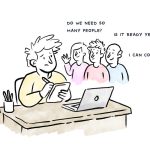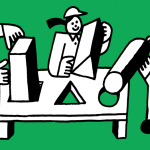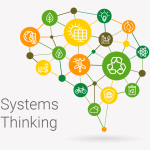Adopting AI in product design requires rethinking work dynamics, crafting scalable AI-driven experiences, and expanding technical fluency across roles.
Throughout 2025, my sole focus as Design Manager is AI. I’ve been working on understanding brand-new AI tools, with a focus on incorporating them into product design dynamics. This new quest stems from a new company vision (I’m assuming, as many others) that has given me a broader perspective on current product processes and roles to be considered and reframed.
A new piece on the board
Days of building products based on waterfall dynamics have passed a long time ago; even agile methodologies start to seem obsolete now; why? There is a new kid on the block: the AI and the promise of speeding things up.
Initially, as I delved deeper into this “new technology,” I found myself in an unexplored environment that no one has fully grasped; this means that everything is about learning and exploring, which is beneficial for all of us.
One of the learnings (if not the biggest) about this new journey is to realize the multiple impacts AI has made so far within teams, and it is not only a matter of design tools but also how we start to understand and interact with it from several business approaches. In addition, I’ve also noticed that starting to name things, create definitions, and build new dynamics based on the company’s needs is a good step toward harnessing all the knowledge and creating a “unique flavor” for teams.
New impact fronts to consider:
Fully adopting the AI label implies more than just incorporating new tools into product teams. As we explored how to find a new way of working, my team and I discovered that integrating this technology impacts other aspects of the company, extending beyond the design process.
So far, the way we build products and interact with each other starts to feel different (work dynamics), the way we are integrating new AI features and solutions to existing products opens new user behavior challenges (AI experiences or IUI), and last but not least, it seems like having UI/UX or product knowledge is not enough to prosper in product development, so new technical upskilling sounds like a necessity (technical knowledge).
This first front is affected for obvious reasons: we no longer work the same way in product teams, and through AI, we can achieve rapid results more efficiently; this is what I can analyse so far.
The impact:
Since almost everyone is capable of building a digital product in minutes, some existing roles start to blur; now, PMs and developers can “make high definition” designs, and designers can “make” front-end code, so is the product profile overlap an imminent challenge now?
This phenomenon can generate uncertainty, a particular amount of paranoia, and fanaticism in the digital community, where it is already being claimed that some roles are going to die, which ends up being detrimental to us.
For more context:
Design Isn’t Dead. You Sound Dumb — Nate Schloesser
Analysis:
Not everything is a matter of falling into despair and hysteria, as I mentioned before, this can be an opportunity to generate new scenarios within the teams and test them until you have something very suitable that works with the company’s context.
We framed this situation as a stage of development called acceleration, which enables us to leverage the overlapping of roles to benefit the product and achieve results more quickly.
Early hypothesis:
Beyond being a threat, AI can expand the range of influence of product roles. The divisor line within the triad is now thinner than ever. In a complete collaboration environment, products can be fully nurtured through unique approaches, which was uncommon among teams months ago.
The second front refers to how we build AI experiences in the existing products. Just as work dynamics must be rethought to make them work better, all product experiences we build must also start to feel like they are part of a new, coherent, and scalable system.
The impact:
Immediately after manipulating AI tools or agents, the very next step is to offer AI solutions to customers. This new scenario, where companies can capitalize on TTM (time to market metrics), can be a focus for building uncontrolled and unscalable experiences.
Although building products faster than before is highly appealing to companies, a clear vision for experience should emerge, providing guidelines to navigate the chaos of product development.
Analysis:
Appealing to a basic UX principle — connecting dots, naming things, and understanding them — can be a smart move here. One of the first things we did as a design team was to document and classify all the incoming product experiences to create a solid system that would eventually enable scalable growth.
So far, we have identified some affected milestones in the product design area:
Core experience:
(context + trigger + load + response). This formula is the way services should be structured from now on; it is a simple but effective approach that allows everyone in the company to understand and apply the rules of any AI functionality in the future.
DS impact:
Design Systems are also an essential artifact to analyse. Since new features and incoming experiences are being planned, building a new line of components is a necessity. Why? We want to emphasize that we have “something new” for our users and, as any business, all the new things should stand out and get their attention. Here, the balance between beautiful and functional is crucial.
Types of Initiatives:
When building a product, it is essential to identify the expected complexity; therefore, we classified AI experiences according to dimension and technical sophistication.
- New functionality in an existing product (AI trigger with specific user flow, i.e, “summarize with AI”)
- Subproduct (new complete experience in an existing product, i.e, tab of AI analysis)
- New Product (brand new end-to-end service with its information architecture, i.e, conversational chat wrapper)
Early hypothesis:
Falling into a mess is easy when you are entering an unknown technological field, but don’t despair; everything is part of the journey. In scenarios like this, experienced designers can map systems that allow peers to navigate better through continuously evolving ways of work. This strategic move can make the difference between being one company that only adapts to the AI trend and one that embraces and scales solid AI solutions.
The final front is about embracing new knowledge; there’s no question that AI has a lot to offer, but when people are not open to learning, they might be left behind in the new industry requirements, so maybe we all need to reframe our sets of technical skills.
The impact:
To master the full range of AI solutions (tools, agents, integrations, etc), some non-tech roles have been struggling with the required language to get optimal results. In my case and my team’s, we’ve found that creating better prompts when creating a functional interface or product requires speaking in basic code language, such as HTML syntax, CSS styles, and basic JavaScript. So, in a way, we’re back to the 2010s, when there was no such thing as UI/UX designers; instead, web designers covered a broader range of responsibilities, including interface and code development.
Analysis:
Based on that new design landscape, we came up with “functional designs.” This concept enables us to understand the rising design range, moving beyond purely visual design to deliverables that align with the company’s tech stack and functions with high complexity. To get functional designs, it is necessary to elevate technical skills, and we’re still studying new abilities.
Early hypothesis:
The need for technical knowledge is increasing rapidly. To make the acceleration stage work properly, there is a catch: PMs and designers should transition from a sole business and visual vision to a deeper technical immersion (how deep? Well, it depends on the company’s strategy). This idea does not invalidate the previous expertise; on the contrary, we realized that it improves the skills of project managers and designers to face future challenges.
For more context: Designers need to be generalized specialists nowadays — here’s how AI can help — Kai Wong.




